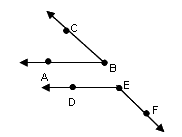Supplementary and Complementary Angles
There are two special types of angles. These two special angles are straight angles and right angles.
| A straight angle is an angle whose measure is 180°. |
As you can see,below is a straight angle because it opens to form a straight line.
![]()
| When two angles make a straight angle when placed next to each other, the sum of the two angles is 180°. They are called supplementary angles. |
Supplementary angles can be adjacent (sharing a common side) or non-adjacent (not sharing a common side).

Angles ABC and DEF are non-adjacent supplementary angles
| An angle whose measure is 90° is called a right angle. |
below is a right angle.

| When two angles make a right angle when placed next to each other, the sum of the two angles is 90°. They are called complementary angles. |
and
are adjacent, complementary angles.
